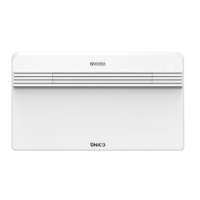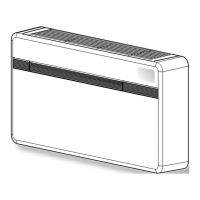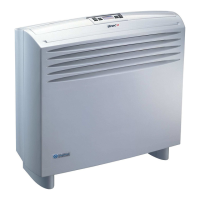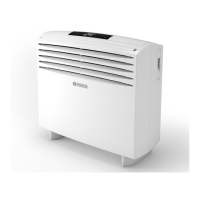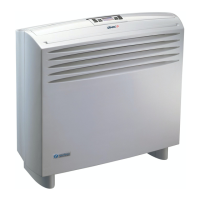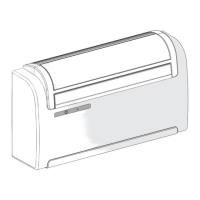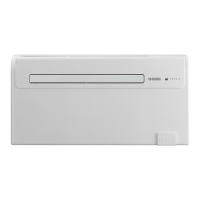Do you have a question about the Olimpia splendid Unico Twin and is the answer not in the manual?
| Cooling Technology | Inverter |
|---|---|
| Heating Capacity | 2.5 kW |
| Energy efficiency class cooling | A |
| Energy efficiency class heating | A |
| Power Consumption (Heating) | 800 W |
| Refrigerant | R410A |
| Weight | 39 kg |
| Power Supply | 220-240V / 50Hz |
| Type | Air Conditioner |
| Cooling Capacity | 2.5 kW |
| Power Consumption (Cooling) | 0.8 kW |
Provides general safety guidelines and warnings regarding the appliance and its usage.
Provides introductory notes about the appliance, document confidentiality, and usage guidelines.
Explains various symbols used in the manual to convey important information and warnings.
Details safety symbols indicating potential hazards, warnings, and attention points.
Provides instructions on how to properly dispose of the product and packaging as electronic waste.
Outlines essential safety measures to reduce risks of fire, electric shocks, and injury during operation.
Advises on safe handling, electrical safety, and preventing damage to the unit and surroundings.
Details specific restrictions on using the appliance to prevent damage, injury, and ensure safe operation.
Covers safe handling of refrigerants and compliance with European directives.
Provides information on fluorinated gases and their handling requirements by certified technicians.
Explains the intended use of the air conditioner and the manufacturer's liability for improper use.
Advises against installing the unit in hazardous environments and emphasizes electrical safety.
Lists all parts included with the UNICO TWIN MASTER and WALL units.
Provides guidelines for storing the appliance packaging to protect it from atmospheric agents.
Details how to check for damage and ensure all components are present upon delivery.
Identifies and illustrates the main components of the air conditioner system.
Specifies the necessary calculations and considerations for the room where the air conditioner will be installed.
Details the requirements for choosing the best position for the indoor unit for optimal performance and safety.
Provides step-by-step instructions for the correct installation of the UNICO MASTER model.
Explains the general process for assembling the unit and pipe specifications.
Guides on drilling the necessary holes in the wall for unit installation, emphasizing tool usage and safety.
Details how to prepare and connect the condensate drain pipe, including slope and winter protection.
Explains how to assemble the air ducts and external grids, including handling plastic sheets and chains.
Guides on preparing the unit for air passage with specific hole diameter requirements.
Details how to position and fix the appliance to the wall using the mounting bracket.
Outlines essential checks and requirements for connecting the appliance to the power supply safely.
Explains how to configure the unit for top or bottom installation and adjust the flap.
Provides instructions for installing the UNICO WALL model, emphasizing electrical system compliance.
Details the process of mounting the fastening plate on the wall, including drilling and leveling.
Guides on creating holes for piping and electrical connections, ensuring proper slope for drainage.
Explains how to connect the left, right, and rear piping for the unit.
Details the connection of the drain pipe, ensuring it slopes downwards for proper drainage.
Guides on making electrical connections to the terminal board and securing cables.
Provides guidelines on using special copper pipes for cooling and insulation requirements.
Details how to check for leaks after making pipe connections using nitrogen and soapy water.
Explains the process of creating a vacuum in the system to remove impurities using a vacuum pump.
Guides on filling the system with coolant after testing and vacuuming.
Details the installation of the communication cable between the UNICO MASTER and WALL units.
Offers recommendations for reducing energy consumption, such as filter cleaning and closing windows.
Emphasizes that installation must be by specialized personnel and warns against obstructing airflow.
Describes the keys and LEDs on the appliance's warning panel.
Lists the operating conditions and corresponding LED indicators on the control panel.
Explains how to operate the unit manually when the remote control is unavailable.
Introduces the remote control and its handling, operation, and potential interference.
Details how to insert and replace batteries in the remote control, including safety precautions.
Advises on the optimal placement of the remote control for effective signal reception.
Explains the functions of each button on the remote control for operating the air conditioner.
Describes the meaning of various symbols and indicators shown on the remote control display.
Explains how to reset all settings on the remote control to default.
Details how to turn the air conditioner unit on and off using the power switch and remote control.
Explains the automatic mode where the unit adjusts temperature and fan speed based on room conditions.
Details how to activate and use the cooling mode for dehumidifying and cooling the room.
Describes the dehumidification mode for removing excess humidity from the room.
Explains the ventilation mode for circulating air without temperature or humidity control.
Details the heating mode operation and its defrost cycle.
Guides on how to adjust the direction of the airflow using the remote control.
Explains how to select different fan speeds for optimal air circulation.
Describes the night well-being mode for gradual temperature adjustments during sleep.
Guides on how to set the correct time on the remote control for timer functions.
Explains how to set activation and deactivation times for two different timer programs.
Details how to activate or deactivate the programmed timer settings.
Explains how to distinguish normal operation from anomalies and run self-diagnosis tests.
Lists functional aspects of the appliance that are not actual anomalies.
Provides a table of common malfunctions, their causes, and recommended solutions.
Emphasizes switching off the unit and disconnecting power before performing maintenance or cleaning.
Provides installation and safety warnings specific to the UNICO WALL unit.
Describes the warning panel and indicators on the UNICO WALL unit.
Lists the operating conditions and corresponding display/LED notifications for the WALL unit.
Explains how to operate the WALL unit manually when the remote is unavailable.
Details inserting and replacing batteries in the remote control for the WALL unit.
Advises on the optimal placement of the remote control for effective signal reception.
Explains the functions of each button on the remote control for the WALL unit.
Explains how to reset all settings on the remote control to default for the WALL unit.
Details how to turn the WALL unit on and off using the power switch and remote control.
Details operation of Spa, Cooling, and Dehumidification modes for the Wall unit.
Explains Ventilation and Heating mode operations for the Wall unit.
Guides on adjusting airflow direction and controlling fan speed for the Wall unit.
Describes Silent Mode operation and introduces the timer function for the Wall unit.
Guides on setting the clock and initial timer program for the WALL unit.
Details setting activation and deactivation times for two timer programs on the WALL unit.
Explains how to activate or deactivate timer programs for the WALL unit.
Guides on diagnosing inconveniences and performing self-diagnosis tests on the WALL unit.
Lists functional aspects of the WALL unit that are not actual anomalies.
Provides a table of common malfunctions for the WALL unit, their causes, and solutions.
Emphasizes switching off the unit and disconnecting power before performing maintenance or cleaning.
Provides instructions for cleaning the appliance and remote control using dry or slightly damp cloths.
Details the process for cleaning the air filter for both UNICO and WALL units.
Outlines routine maintenance operations like air filter cleaning and condensing battery cleaning.
Provides instructions for temporarily draining condensate in case of system anomalies.
Lists technical specifications, dimensions, and weight for UNICO MASTER and WALL units.
Defines the maximum and minimum operating temperatures for cooling and heating modes.

